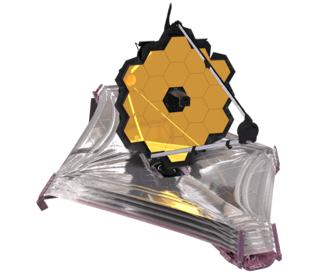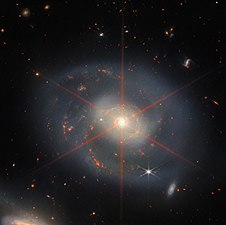
A primary mirror is the principal light-gathering surface of a reflecting telescope.
Timeline of telescopes, observatories, and observing technology.

The Large Binocular Telescope (LBT) is an optical telescope for astronomy located on 10,700-foot (3,300 m) Mount Graham, in the Pinaleno Mountains of southeastern Arizona, United States. It is a part of the Mount Graham International Observatory.

The W. M. Keck Observatory is an astronomical observatory with two telescopes at an elevation of 4,145 meters (13,600 ft) near the summit of Mauna Kea in the U.S. state of Hawaii. Both telescopes have 10 m (33 ft) aperture primary mirrors, and, when completed in 1993 and 1996, they were the largest optical reflecting telescopes in the world. They are currently the third and fourth largest.

A Ritchey–Chrétien telescope is a specialized variant of the Cassegrain telescope that has a hyperbolic primary mirror and a hyperbolic secondary mirror designed to eliminate off-axis optical errors (coma). The RCT has a wider field of view free of optical errors compared to a more traditional reflecting telescope configuration. Since the mid 20th century, a majority of large professional research telescopes have been Ritchey–Chrétien configurations; some well-known examples are the Hubble Space Telescope, the Keck telescopes and the ESO Very Large Telescope.

The Mauna Kea Observatories (MKO) are a group of independent astronomical research facilities and large telescope observatories that are located at the summit of Mauna Kea on the Big Island of Hawaiʻi, United States. The facilities are located in a 525-acre (212 ha) special land use zone known as the "Astronomy Precinct", which is located within the 11,228-acre (4,544 ha) Mauna Kea Science Reserve. The Astronomy Precinct was established in 1967 and is located on land protected by the Historical Preservation Act for its significance to Hawaiian culture. The presence and continued construction of telescopes is highly controversial due to Mauna Kea's centrality in native Hawaiian religion and culture, as well as for a variety of environmental reasons.

The Gran Telescopio Canarias is a 10.4 m (410 in) reflecting telescope located at the Roque de los Muchachos Observatory on the island of La Palma, in the Canary Islands, Spain. It is the world's largest single-aperture optical telescope.

The James Webb Space Telescope (JWST) is a space telescope designed to conduct infrared astronomy. Its high-resolution and high-sensitivity instruments allow it to view objects too old, distant, or faint for the Hubble Space Telescope. This enables investigations across many fields of astronomy and cosmology, such as observation of the first stars and the formation of the first galaxies, and detailed atmospheric characterization of potentially habitable exoplanets.

The Gemini Observatory comprises two 8.1-metre (26.6 ft) telescopes, Gemini North and Gemini South, situated in Hawaii and Chile, respectively. These twin telescopes offer extensive coverage of the northern and southern skies and rank among the most advanced optical/infrared telescopes available to astronomers. (See List of largest optical reflecting telescopes).

The Southern African Large Telescope (SALT) is a 9.2-metre optical telescope designed mainly for spectroscopy. It consists of 91 hexagonal mirror segments each with a 1-metre inscribed diameter, resulting in a total hexagonal mirror of 11.1 by 9.8 m. However, its effective aperture is only 9.2 m. It is located close to the town of Sutherland in the semi-desert region of the Karoo, South Africa. It is a facility of the South African Astronomical Observatory, the national optical observatory of South Africa.

The Hobby–Eberly Telescope (HET) is a 10-meter (30-foot) aperture telescope located at the McDonald Observatory in Davis Mountains, Texas.

Roque de los Muchachos Observatory is an astronomical observatory located in the municipality of Garafía on the island of La Palma in the Canary Islands, Spain. The observatory site is operated by the Instituto de Astrofísica de Canarias, based on nearby Tenerife. ORM is part of the European Northern Observatory.

Submillimetre astronomy or submillimeter astronomy is the branch of observational astronomy that is conducted at submillimetre wavelengths of the electromagnetic spectrum. Astronomers place the submillimetre waveband between the far-infrared and microwave wavebands, typically taken to be between a few hundred micrometres and a millimetre. It is still common in submillimetre astronomy to quote wavelengths in 'microns', the old name for micrometre.

The Thirty Meter Telescope (TMT) is a planned extremely large telescope (ELT) that has become controversial due to its location on Mauna Kea, on the island of Hawaiʻi. The TMT would become the largest visible-light telescope on Mauna Kea.
The Ohana project aims to use seven big telescopes on top of Mauna Kea, Hawaiʻi Big Island, in an interferometer configuration. Mauna Kea is a former volcano whose height is 13,600 ft. It is a good site for telescopes which probe the universe in the optical and infrared wavelengths because of its altitude and low levels of light pollution.
Jerry Earl Nelson was an American astronomer known for his pioneering work designing segmented mirror telescopes, which led to him sharing the 2010 Kavli Prize for Astrophysics.

Charles Mattias ("Matt") Mountain is currently the President of the Association of Universities for Research in Astronomy (AURA) which designs, builds, and operates telescopes and observatories for the National Science Foundation (NSF) and the National Aeronautics and Space Administration (NASA). AURA's NASA center is the Space Telescope Science Institute (STScI), responsible for the science mission for the Hubble Space Telescope, the science and operations for the James Webb Space Telescope, and the MAST data archive. AURA's NSF centers are Gemini Observatory, the National Optical Astronomy Observatory (NOAO), and the National Solar Observatory (NSO). Dr. Mountain and AURA are also responsible for the NSF construction projects: the Daniel K. Inouye Solar Telescope (DKIST) on Haleakalā, Hawaii and the Large Synoptic Survey Telescope (LSST) on Cerro Pachón in Chile.

Optical Telescope Element (OTE) is a sub-section of the James Webb Space Telescope, a large infrared space telescope launched on 25 December 2021, consisting of its main mirror, secondary mirrors, the framework and controls to support the mirrors, and various thermal and other systems.

Guido Horn d'Arturo was an Italian astronomer born in Trieste, then part of the Austrian Empire. He obtained Italian citizenship after serving as a volunteer in the Italian army during the First World War. To avoid being persecuted as an irredentist by the Austrian authorities, he officially added to his surname Horn that of "d'Arturo" which he used in the war.




























